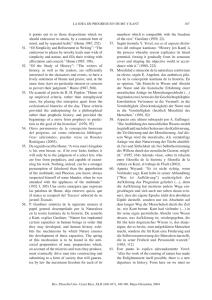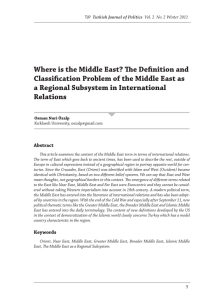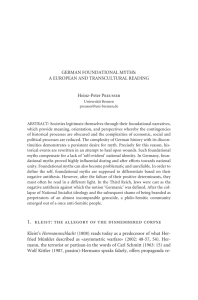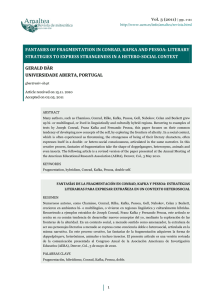Social and work integration projects in Spain and Germany from the
Anuncio
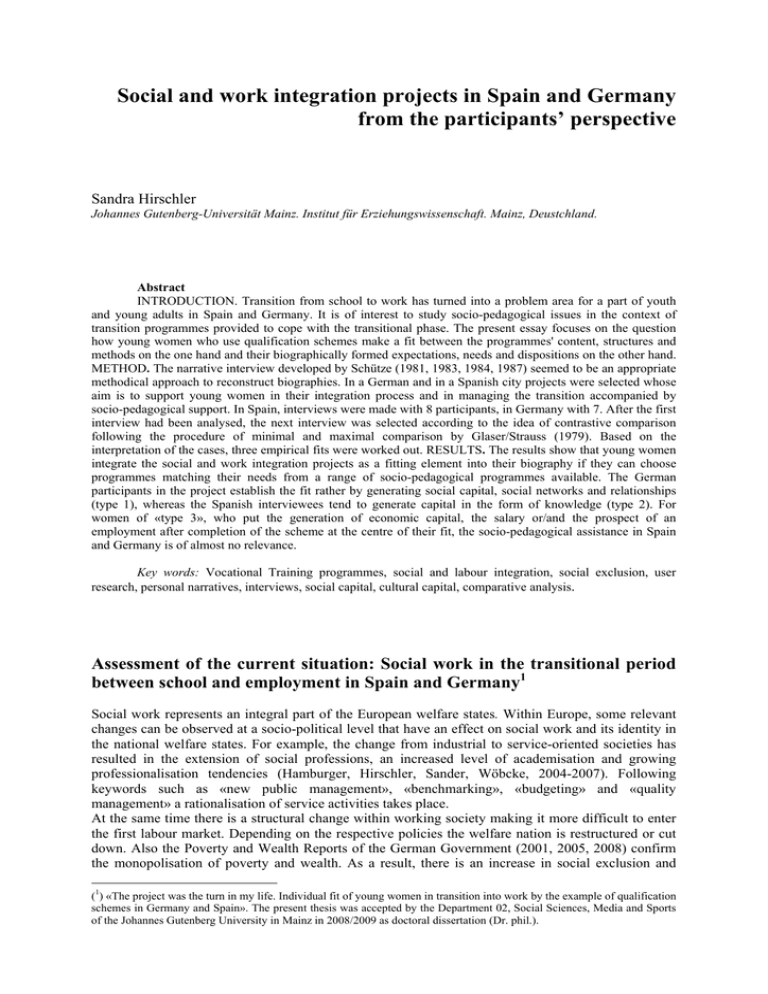
Social and work integration projects in Spain and Germany from the participants’ perspective Sandra Hirschler Johannes Gutenberg-Universität Mainz. Institut für Erziehungswissenschaft. Mainz, Deustchland. Abstract INTRODUCTION. Transition from school to work has turned into a problem area for a part of youth and young adults in Spain and Germany. It is of interest to study socio-pedagogical issues in the context of transition programmes provided to cope with the transitional phase. The present essay focuses on the question how young women who use qualification schemes make a fit between the programmes' content, structures and methods on the one hand and their biographically formed expectations, needs and dispositions on the other hand. METHOD. The narrative interview developed by Schütze (1981, 1983, 1984, 1987) seemed to be an appropriate methodical approach to reconstruct biographies. In a German and in a Spanish city projects were selected whose aim is to support young women in their integration process and in managing the transition accompanied by socio-pedagogical support. In Spain, interviews were made with 8 participants, in Germany with 7. After the first interview had been analysed, the next interview was selected according to the idea of contrastive comparison following the procedure of minimal and maximal comparison by Glaser/Strauss (1979). Based on the interpretation of the cases, three empirical fits were worked out. RESULTS. The results show that young women integrate the social and work integration projects as a fitting element into their biography if they can choose programmes matching their needs from a range of socio-pedagogical programmes available. The German participants in the project establish the fit rather by generating social capital, social networks and relationships (type 1), whereas the Spanish interviewees tend to generate capital in the form of knowledge (type 2). For women of «type 3», who put the generation of economic capital, the salary or/and the prospect of an employment after completion of the scheme at the centre of their fit, the socio-pedagogical assistance in Spain and Germany is of almost no relevance. Key words: Vocational Training programmes, social and labour integration, social exclusion, user research, personal narratives, interviews, social capital, cultural capital, comparative analysis. Assessment of the current situation: Social work in the transitional period between school and employment in Spain and Germany1 Social work represents an integral part of the European welfare states. Within Europe, some relevant changes can be observed at a socio-political level that have an effect on social work and its identity in the national welfare states. For example, the change from industrial to service-oriented societies has resulted in the extension of social professions, an increased level of academisation and growing professionalisation tendencies (Hamburger, Hirschler, Sander, Wöbcke, 2004-2007). Following keywords such as «new public management», «benchmarking», «budgeting» and «quality management» a rationalisation of service activities takes place. At the same time there is a structural change within working society making it more difficult to enter the first labour market. Depending on the respective policies the welfare nation is restructured or cut down. Also the Poverty and Wealth Reports of the German Government (2001, 2005, 2008) confirm the monopolisation of poverty and wealth. As a result, there is an increase in social exclusion and (1) «The project was the turn in my life. Individual fit of young women in transition into work by the example of qualification schemes in Germany and Spain». The present thesis was accepted by the Department 02, Social Sciences, Media and Sports of the Johannes Gutenberg University in Mainz in 2008/2009 as doctoral dissertation (Dr. phil.). deprivation while at the same time distributive justice is decreasing. The social professions are called to react in an appropriate way. Social workers are thus turned to «deprivation managers»; they look after the «dregs of exclusion» (Kronauer, 2002), which are to be «activated». Another important factor is paraphrased by the abbreviation GATS (General Agreement on Trade in Services). In 1995, GATS was included into the treaties of the World Trade Organization (WTO) representing the first agreement on global liberalisation of service markets. Service sectors such as medical and social services as well as education and culture are to be subject to the WTO principles of free market access and equal rights for domestic and foreign suppliers. These services have mainly been protected by domestic regulations until now. Now, «providers» of social services have to deal with subjects such as competitive orientation, opening-up of the market, liberalisation and privatisation. Another dynamic that can be observed is that some of the deprived groups, for example unemployed youths or elderly people, are usually almost non-existing in the public discourse transported by the media. In contrast, since 2008 the German TV programme Die Ausreißer – der Weg zurück (the runaways - the way back) has shown how homeless young people are reunited with their families; and in Teenager außer Kontrolle - letzter Ausweg Wilder Westen (teenagers out of control – the Wild West as a last resort) «the young people, mostly affected by deprivation, undergo an outdoor adventure-educational behaviour therapy» (www.rtl.de). Thus, the existence of short-term «excluded trendy groups» in the media can be stated. These are a few examples for the change processes social work in all European welfare states has been confronted with. For example, social work has to meet the challenge – also in the context of GATS – to «maintain its position» within the service-oriented society. Its task includes all groups of people, not only those deprived or excluded groups currently addressed by the media. However, social work must also be required not only to «manage» deprivation and exclusion but to strengthen the agency of the affected individuals and to consider them as active users of «social work as a service». Exclusion and deprivation – what does it actually mean? Often the terms «deprivation» and «exclusion» are used differentially in the literature, with «deprivation» referring to a temporary negative state, and in contrast «exclusion» to a prolonged negative state (cf. Haisken-DeNew, Sinning, 2007). In the empirical analysis, we shall focus on short-term deprivation and then on long-term social exclusion. Exclusion has replaced the concept of poverty2 at a European level and, as a consequence, been adapted to the national framework of poverty research and entered into the national contexts even of countries in which the term had not been used before. It focuses on guaranteeing social rights, on participation and integration aspects, on multi-dimensional and long-term deprivation. In the following, two states belonging to different types of regime3, Spain and Germany are taken as an example to show a few characteristics of the two welfare states while focussing on the transition from school to employment and the role of social work. The transition from school to employment has been chosen because deprivation and exclusion of young people who do not possess sufficient capital (particularly cultural, social and economic capital) to independently manage their way into the first labour market is distinctly visible at this point. During this transitional period, social work is especially present in youth job support projects and job preparatory programmes. The continental or conservative type of regime focuses on subsidiarity combined with solidarity, as can be seen at the German example, particularly in the field of social services. For instance with regard to § 93 BSHG (Ley nacional de seguridad social) and § 5 JWG (Ley de bienestar social de jóvenes) private charity organisations have priority by the granting of funds to public welfare organisations. Maintaining status differences is another one of its characteristics (Eichenhofer, 2007). Social security funds, representing the core of social security systems, are directly or indirectly (for family members) coupled with the employment status. Social work often includes a controlling function; the intervention is connected to a certain degree of stigmatisation. (2) For differences and commonalities of the concepts of «poverty» and «exclusion» see, for example, European Commission, 2004; Nolan/Whelan, 1996. Exclusion, more narrowly defined as social exclusion, can be analysed at different levels, such as relativity (people are always excluded at a certain time, a certain place and by a certain society), agency (cf. Le Grand, 2003), dynamics (people are not (only) excluded because they are jobless at the moment but also because they have little prospects for their future) and related to multiple deprivation (cf. Atkinson/Hills, 1998; Room, 2000). (3) The typologisation of the welfare states by Gøsta Esping-Andersen (1990; in its further development by Lessenich, 1994, 1995; Gallie/Paugam, 2000; Ostner, 1995) takes ‘regimes’ as a starting point, i. e. specific institutional arrangements created by societies to regulate job market and social policies. The concept of regime includes that life courses and biographic orientations are affected by the complex constellations of socio-economic structures, institutions and cultural patterns. Focussing on the transition from the selective school system to the standardized system of vocational training it can be noted that failing in transition is considered foremost an individual risk. If young people fail to manage the transition from school to work, job preparatory programmes such as «training-accompanying assistance», part-time «in-house training» and «vocational training in noncompany facilities» will be adopted. In many cases, job preparatory programmes work as a «waiting list» and are meant to compensate educational and social deficits (Esping-Andersen, 1990). The rudimentary type of regime, however, only provides a few institutionalized and guaranteed rights. Spanish social security funds are a mixed system of public and private elements. They were mainly characterized by political, economic and social circumstances developing highly unequally (Schmid, 2002, p. 226). In addition, by European comparison, legal entitlement to social security was introduced only late and in a marginalized way. Labour market programmes such as the Programas de garantía social, Escuelas Talleres and Casas de Oficio are offered to young people if the (smooth) transition from school to the (first) labour market fails (cf. Vogel, 2007). However, the transition from school to employment is, in comparison to Germany, under-institutionalized and of rudimentary design. The lack of vocational training structures, lacking rights to social security benefits and highly segmented labour markets result in youths and young adults longer depending on and being stronger anchored in their families. Other consequences are long waiting times, high youth unemployment and many young people «employed» in the informal sector. In some countries of the rudimentary type, issues such as youth unemployment are rather common compared to other types of regime. Due to the high numbers of unemployed youth it is primarily not considered such a «social problem» as in other regimes (Walther, 2006, p. 213). Comparing the two types of regime reveals different ways of coping with the transition to employment. In the conservative-cooperational type of regime the employment sector is highly regulated and job-centred. Dwindling possibilities of obtaining employment involve the risk for job biographic one-way-streets and mechanisms of social exclusion. Young people are allocated to existing standardized job positions. Only those disposing of high educational capital (cf. Bourdieu, 1983) have the choice. In rudimentary, under-institutionalized types of regime such as the Spanish system the employment sector is not as highly regulated and job-centred as in conservative regimes. The transition from school to employment is characterized by longer waiting periods during which young people depend foremost on their parents and family. In Spain, youth unemployment rates are significantly higher (02/2009: 31.8%) than in Germany (02/2009: 10.3%; Eurostat, 2009). There seems to be less exclusion of young people because youth unemployment is first of all explained by structural deficits and the resulting structure-related concept of disadvantage. Thus the consequences of unemployment and job instability are softened by «social normalisation and approving acceptance» (Kieselbach/Beelmann, 2003, 35). When turning from the types of regime to the concrete «country level» it becomes visible that the (subjective) extent of social and economic exclusion is distinctly lower in Spain than in Germany (Kieselbach, Beelmann, 2003). In Spain, young people stay longer with their families than in Germany (Ministerio de Trabajo y Asuntos Sociales, 2007). There is a «postponing of independence of young people until their late 20ies» (Laparra/Aguilar, 1998, 402). In Spain, other than in Germany, support by the family seems to be a central instance of assistance4. The «postponement of independence’ is also recognizable by the fact that households often have to combine a stable income (mostly by the male adult breadwinner) with low (pension, unemployment benefit) and instable incomes (part-time job, temporary work). 5 With respect to the transition from school to employment it can be noted that the German educational system provides far more selective preparation for vocational training than the Spanish system. In Germany, transition into vocational training, for example the system of dual education (combination of in-firm training and vocational school), is characterized by relatively strict (4) For example, in the context of a study half of all young Spanish adults explained that they only obtained a job through social capital in form of family and friends (Field, 2003, 52). When comparing the life situations of youths and young adults in both regimes it can be noted that in Germany the main source of income of young adults is labour (SardeiBiermann/Kanalas, 2006, 70f), whereas in Spain it is the parents. In Spain, only 15% of the youths and young adults receive state aid (Moral, 2002, 264). (5) For example, 64.85 % of the 15 to 24 year old pursue a temporary job in Spain – compared to an average of 38.7% in the EU (Navarrete Moreno, 2007, 14 f.). requirements and standards for access and direct transition to labour is not common. In Spain, the transition from school to employment is more pervious than in the German system, formal qualifications are less important than informal networks. Overall, it can be stated that in the Spanish society – in contrast to Germany – there is a combination of high social uncertainty and low social exclusion. The short outline of the two different types of regime and countries illustrates the strong impact of sociopolitical situations on (nationally designed) social work and consequently on the significance of social workers in society. Simultaneously, «the practice in every country [meets with] certain basic issues that, in the first place, enable communication and allow to recognise the benefit of comparative perspectives» (Lorenz, 1996, 54). This avoidable paradox gives rise to the question whether social work in its activities «on the job» – which is framed by nation state sociopolitical circumstances –, when working with deprived and excluded youths and young adults, really takes such a different approach as it may be assumed given the divergent framework (Treptow, 2004), or whether it follows similar mechanisms at the practical level, as stated by Walter Lorenz (1996). Based on the changes described above, the presumption is near that also social work «on the job throughout Europe» will have to adapt to the changing conditions. According to Thomas Rauschenbach (1994), «solidarity» and social capital will disappear «from the sphere of human relations» due to the transformation and modernisation processes described. Something else will have to replace them. Following Rauschenbach, this may mean an increase in importance of social work. As a new form of «staged communities» it is [...] part of a public resource of the «social» that has been produced». In this sense, social work is an «instrument to ensure person-related social services in form of a secondary institutionalisation, i. e. an answer of society to socially produced social disparities and needs» (Rauschenbach, 1994, p. 96). What is needed is a paradigm shift, a change towards adequate social work corresponding to the given social circumstances. The service-oriented approach seems to be useful as through its radical turn to the user perspective6 it offers the chance to realize a paradigm shift in the direction of adequate social work corresponding to the given social circumstances. The research design The brief description of the conservative and rudimentary type of regime has shown that social work is tied to nation state frameworks but that, however, the latter are facing similar challenges throughout Europe. Therefore, social work as a «response of society to socially produced social disparities and needs», as Rauschenbach puts it, is also a European social response to the challenges that need to be coped with. At the centre of social work is the individual person, called the «user» in the terminology of service-related social work. Consequently, the perspective of the user – exemplary the user of social work in the transitional period between school and employment – is at the centre of the study. The social work effected in the frame of job assistance projects for young people on the threshold between school and employment has been an obvious example for a practice area of social education. At this threshold, deprivation and exclusion become especially clear, for example, young people without sufficient capital «shipwreck» at this point. In most cases their possibilities to independently manage the transition to the first labour market are quite limited. Moreover, this point of transition to employment represents a special challenge to social work in the service-oriented societies as labour is highly valued and the «normal employment» is appreciated as a highly desirable good which can, however, often not be achieved due to lacking job opportunities. Social work in job-preparatory programmes faces the dilemma of training young people for jobs without a secure future economic benefit, i. e. possible employments. In doing so, the activities of social work have the task to reduce inequalities and to support deprived youths and young adults in achieving «successful transitions». (6) The concept of the user applied in the study refers to the service-theoretical research approach. Users of social work are people who are in direct interaction with the aid system and the corresponding professionals or who make use of professionally provided social services to cope with their own specific problems. For research on users see particularly Schaarschuch, 1998. This support is part of the structured offer taking the form of programmes, staff, organisation and situation. It is a support that must subjectively be experienced as such by young people and that needs to be tailored to the individual situation. Otherwise, the young people – if they take part voluntarily en los proyectos de inserción socio-laboral – will soon drop out of the social work programmes. Subjectively experienced support is the means for perceiving the use of and the individual fit with social work. Individual fit is generated by subjectively experienced support. According to Hanses (2003), individual agency and biographical resources are often not taken into account within the framework of professional socio-pedagogical contexts. Then, due to the «socio-pedagogical disregard» of the individual biographical dimension, individuals would not accept any necessary support programmes available. What kind of activity and design is needed for social work in social and work integration projects so that individuals can integrate it into their biography as an individually fitting part? In this context, the concept of fit is not used in a normative sense, but rather understood as acceptance and integration of social work into one's own biography. Consequently, the key research question is: How do young women in Spain and Germany develop the individual fit between socio-pedagogical qualification and employment schemes and their own biography? Methodological basis Tracing and working out the individual fit, acceptance and integration of the socio-pedagogical qualification and employment schemes in the young women’s biographies requires the reconstruction of their biographies. The narrative interview developed by Fritz Schütze (1981, 1983, 1984, 1987) seemed to be an appropriate methodical approach to reconstruct biographies. In most cases, the objective of a narrative interview is to gain additional information about the interviewee that cannot be obtained by standardised surveys or tests, like, for instance, the question regarding subjectively experienced support. The method allows very specific and individual problems of the interviewee to be revealed. The research process and the research design The research question refers to the individual fit of young women participating in qualification schemes for the integration into the first labour market, i. e. who are in transition – «into the society». Therefore, only those projects were selected whose project aim is to support young women in their integration process and in managing the transition accompanied by socio-pedagogical support. Participation in the project should be preceded by the existence of exclusion criteria representing obstacles to successful job seeking such as «(female) youth unemployment», «school absenteeism», or «young and single parent» (cf. Paul-Kohlhoff/Paul/Zybell, 2001) and that are similarly defined throughout European societies. These should be the admission criteria for participating in the scheme. The criteria were selected on the basis of tendencies described as primary exclusion reasons in both countries. For Germany, «young and single parent» was selected as an exclusion criterion. With young single parents the cumulation of the different discriminations in the transition phase becomes especially apparent. In Germany, the poverty rate of single parents is relatively high compared to other European countries. «Young and single parent» means the divergence in many ways from established institutionalized schedule models, from successive phases of qualification and transition that point the way ahead. Examples are missing school leaving certificates or low education, dropouts from vocational training and precarious job situation (for figures, cf. Hovestadt, 2003). Compared to their cohorts, young mothers have to make their living assisted by transfer payments of the welfare state more often than average (cf. Nader, Paul, Paul-Kohlhoff, 2003, 17 ff., 30 ff.; Hammer, 2003; Lex, 1997, 260 f.; Zybell, 2003, 55 ff., Geissler, Oechsle, 1994). School absenteeism, including academic failure, early school leaving and truancy, in general «difficulties in achieving objectives set by the educational system» (Navarrete Moreno, 2007b, p. 5), was selected as the criterion for Spain. It is obvious that for the integration into the first labour market having no school leaving certificate or only low education is a disadvantage. The consequence is quicker and longer unemployment, and it is also more difficult to find a new job (Schönmann, Kruppe, Oschmiansky, 1998, p. 101). School absenteeism was selected as an exclusion criterion because with its 30.8% Spain is the country having the most school-leavers without a school certificate after Portugal (EU average: 15.2 %, Germany: 13.8 %) (cf. European Communities, 2007; Navarrete Moreno, 2007, a, b; Ministerio de Educación y Ciencia, 2007; Observatorio de Vivienda Joven, 2006). But at the same time, a school-leaving certificate is a crucial element for successful transition. Another important criterion for the project selection was that the selected projects served as models. Therefore, projects were searched for that had been assessed as best practice and co-financed by the European Social Fund, as in this way the criteria of evaluation and comparability in the sense of the funding regulations of the European Social Fund were given. The restriction to one project each took place to ensure better comparability within the projects. Selected were projects working with young female participants aged 16 to 27 who were excluded or affected by exclusion (in the sense of academic failure or single parent). The young women should have almost completed or already fully completed their participation in the social and work integration project so that they would be able to reflect and describe the project. The project JAMBA (abbreviation of the German designation for young single mothers in vocational training), financed by the European Social Fund, was labelled a model project by the ministry of social affairs of the corresponding German Land7. Single mothers – and young single fathers (in 2004, 85% of single parents in Germany were women; in 2007, the percentage increased to more than 90%, cf. German Federal Statistical Office, 2006 and 2008) – younger than 27 shall be encouraged and supported to do a vocational in-house training in the context of the dual education8 standard system. JAMBA provides the possibility to simultaneously complete a vocational qualification training and fulfil family duties. Further to socio-pedagogical support it is especially important that the training takes place part-time. Daily training time is shortened to 75% of the regular training time. The Casa de Oficio in Viña, Spain, was introduced as a best practice project in the transition phase, aiming at the integration into the first labour market through school and vocational qualification of poorly qualified young adults, supported by pedagogues (cf. Sotomayor Morales, 2007, 118 ff.). The selected Spanish project Sastrería de Trajes Tradicionales II is a one-year job preparatory course. In the course, which then took place the second time aiming at the integration into the first labour market through school and vocational qualification, the twenty 16 to 24 year old women are trained to become tailors. Before the start of the project, they had been registered as unemployed and jobseeking with the municipal job agency. Due to school absenteeism or academic failure, many of them do not possess a school leaving certificate. In Spain, interviews were made with eight project participants, in Germany with seven, of which three interviews per country were included in the evaluation9. After the first interview had been analysed, the next interview was selected according to the idea of contrastive comparison following the procedure of minimal and maximal comparison10. By way of contrastive comparison of the single cases and cross-case generalisations, general processes could be worked out. Based on the interpretation of the cases, three fits, i.e. three different possibilities of how young women integrate the projects into their biography, were worked out. The three fits and further results derived from them are described in the following. (7) As far as possible, the names of the towns where the projects take place were anonymised. Viña in Spain and Wilmar in Germany are fictitious names. The same applies to all other names occurring in the text. The research literature was anonymised, it can be viewed by appointment with the author. (8) After having finished school, most young people in Germany – almost two thirds of an age group – start their vocational training by doing an apprenticeship, i. e. within the concept of dual education. The system is called ‘dual’ because the training takes place at two learning sites, in the company and in the vocational school. (9) Regarding the question of representativeness of the results of narrative interviews see, e.g., Küsters 2006. (10) According to Glaser/Strauss (1979), the principle of minimal and maximal contrast means that similar cases and very different cases are searched for to achieve the broadest possible view of the research field. This constantly repeated process will be continued until a theoretical sampling is established, i.e. when new cases do no longer result in new findings. Results One result was that none of the interviewees is thinking of dropping out of the project. All biography incumbents dispose of the competency to integrate the qualification scheme into their biographies according to their needs. At the same time, it became apparent that in both projects the pedagogical actors possess the competency to use their multi-functional offer in such a flexible way within a given framework of a social service that the biography incumbents can find elements tailored to their needs. The needs differ depending on each individual. Thus, one result of the study is that pedagogical action is subject to the corresponding individual and social constitutional conditions. Social work can only become effective, if it places a multifunctional offer at the individuals’ disposal, from which the individuals can generate the capital they need. It is also the task of social work, when understood as formation of subjectivity, to enable youth and young adults to consciously deal with their own biography and their life situation and build an understanding of themselves and the world, to explain possible decisions and compulsory decisions, to help them develop self-responsible and selfdetermined life plans and activities, to concede action alternatives to them and to convey the feeling of security and recognition. «Encouraging awareness processes» and «allowing self-organisation processes» took place in both projects. It can be stated that an open approach with respect to results on the part of the social work is a key success factor with all participants. The objectives and topics used to develop a fit are to be determined by the individuals; therefore social work is required to focus on them as far as it is possible to integrate the individual objectives into the project context and to manage them within the project. Regardless of two different project designs –developed differently according to nation-state– in most cases the pedagogues of both projects are able to create an openness in the sense that each respondent can obtain support in the situations personally relevant to her. It is to be emphasized that this is a further important result from the interpretation of the biographies, also because it allows for results that go further than comparison. The openness to respond to biographies in a differentiated way and according to needs is an important criterion for enabling the biography incumbents to integrate pedagogical activity into their own biography. Another result of the study is that in the course of developing a fit the entire range of possibilities social work can provide is required to a different extent. The various fits were classified by type. Thus, the first type can be described as «social work as a biographical turn», the second type as «social work as biographical space of learning» and the third type as «social work as biographical marginal category» (see figure 1). The dominant biographical orientation pattern in the first two interviews (type 1) is, that due to the developed fit both young women living in Germany consider the social work as a biographical «turn» in their lives. Supported by social work, the established networks can be used to develop structure and stability along with options for a «new», a «changed» life. In doing so, the development of an individualised fit takes place by generating social capital, either by developing networks assisted by and also in the form of social work (case Nastja) or making use of the manifold support functions of social work (case Nicole). The next two interviews (type 2) were named «social work as biographical learning space» as the two young Spanish women, Verónica and Africa, develop the fit with the social work by learning, although both aim at learning processes due to other motivations. Africa learns «to behave when in company», Verónica trains her cognitive abilities motivated by the aim of helping her daughter. In this context, «learning» is to be understood as learning in the course of time and as «learning» with respect to their personality. The «space» is to be understood as a space to develop possibilities. In the last two interviews (type 3), headed by «social work as biographical marginal category», the subject area «work» is the dominating biographical orientation pattern for the two young women, the German Oli and the Spaniard Tania. In theses cases, social work has just a marginal biographical meaning; it is only relevant in the context of generating economic capital, for instance in the form of an employment (see figure 1). The two first types –«social work as biographical turn» and «social work as biographical learning space»– appreciate quick, uncomplicated assistance and support, they readily accept assistance, important are the approachability of the social worker and the continuity of support. With these two types, also the interest in the entire person, the bond of trust, the possibility to speak about various topics, seem to be relevant. Despite a visibly large extent of variety in the relationships and heterogeneity of the demands, there is an interest in quick and practical support in almost all cases – except those of Oli and Tania (type 3). With Nicole, for instance, an independence initiated by the social worker can be noted, a high level of guidance is necessary because previously Nicole lacked «civil competencies» (Braun, 2006, 233), especially in dealing with authorities, formalities, with the everyday management of her own financial and legal matters. For the second type, additionally the biographical learning space, the circumstances of learning (what, when, how and why do I learn?) are important. For Nicole, partly also for Nastja (both type 1), social work represents the «kick», the «turn», the «sheet anchor». The relations are different, Nicole needs a very close, Oli (type 3) a very distant relationship with the social worker, in order to develop a fit. The typology shows a large range, a considerable heterogeneity of the requirements regarding the fit with –and connected to it the role of– the social work. Based on the results of the third type, «social work as biographical marginal category», a discussion could be initiated on whether it could be valued negatively for the biographies of Oli and Tanja that social work does not create irritations. Here, this question cannot be pursued further, also because of the orientation towards subjectivity, however, it must be stated that at the moment the individuals can develop a positive fit with the social work even if no irritations occur. Also, by analogy with Maar (2006b, 138), the thesis could be proposed that individuals who rather demand material financial support within the professional support system, have stable social resources in the private sector at their disposal. However, based on the two cases constituting the type, this cannot be confirmed as the young women have different reasons for falling back on material assistance and as probably (only) one of them, the Spaniard Tania, has a stable social (family) network at her disposal. Figure I. The generation of capital and the‚ task’ of social work in the project Verónica (type 2: social work as biographical learning space) Social capital very high: developing networks, assisted by and also in the form of social work, can be used to develop structure and stability in life, social worker as ‚significant other’ social work: highly relevant very high: developing networks making use of the manifold support functions (emotional, material, social support) of social work, social worker as ‚significant other’ social work: highly relevant low: the family is the center of her action social work: not relevant Africa (type 2: social work as biographical learning space) low: has two friends in the project social work: not relevant Oli (type 3: social work as biographical marginal category) very low: I fend for myself Social work: not relevant Tania (type 3: social work low: got some friends in the Nastja (type 1: social work as biographical turn) Nicole (type 1: social work as biographical turn) Cultural capital high: pronounced aspiration to higher education, acquirement of a vocational qualification social work: not so relevant Economic capital middle: apprenticeship pay, instrument for getting independent from social welfare social work: not relevant high: graduates from vocational training school with help of social work social work: relevant middle: apprenticeship pay, social worker helps her to prepare the budget social work: relevant high: Verónica develops the fit with the social work by learning, she trains her cognitive abilities motivated by the aim of helping her daughter. In this context, «learning» is to be understood as learning in the course of time and as «learning» with respect to their personality social work: highly relevant high: Africa develops the fit with the social work by learning, she learns «to behave when in company», in job interviews social work: highly relevant middle: wants to graduate from vocational training school for earning money social work: not relevant. middle: learns sewing low: connection with daughter, for buying her presents social work: not relevant low: jobless after the end of the project social work: not relevant very high: hopes to get a job beyond the project social work: not relevant very high: hopes to get a as biographical marginal category) project social work: not relevant social work: not relevant. job beyond the project social work: not relevant Overall –thus it also appears in figure 1– it can be stated that young adults developing a fit with social work in schemes during transition into the first labour market can be supported by an available flexible, multifunctional scheme that is independent of nation-states. In this context, the question seems to be of interest for the young women at which point do they feel excluded and what kind of capital they want to generate (e.g. networks, education, economic resources...). This forms the basis for developing their individual fit with the scheme. National borders do not seem to have a major impact on the project practice, despite different circumstances, different regimes etc. Bibliography BOURDIEU, P. (1983). Ökonomisches Kapital, kulturelles Kapital, soziales Kapital. In KRECKEL, R. (Ed.), Soziale Ungleichheiten. Soziale Welten (pp. 183-192). Göttingen. EICHENHOFER, E (2007). Geschichte des Sozialstaats in Europa. Von der «sozialen Frage» bis zur Globalisierung. München: Beck. ESPING-ANDERSEN, G. (1990). The Three Worlds of Welfare Capitalism. Cambridge: Polity Press. EUROPEAN COMMUNITIES (2007). The social situation in the European Union 2005-2006. The Balance between Generations in an Ageing Europe. Luxembourg: Amt für Amtliche Veröffentlichungen. EUROPÄISCHE KOMMISSION (2004). Gemeinsamer Bericht über die soziale Eingliederung. Brüssel: Amt für Amtliche Veröffentlichungen. FIELD, J. (2003). Social Capital. London, New York: Routledge. GALLIE, D. & PAUGHAM, S. (Eds.) (2000). Welfare Regimes and the Experience of Unemployment in Europe. Oxford: Oxford University Press. GEISSLER, B. & OECHSLE, M. (1994). Lebensplanung als Konstruktion: Biographische Dilemmata und Lebenslauf-Entwürfe junger Frauen. In U BECK & BECK-GERNSHEIM, E. (Eds.), Riskante Freiheiten. Individualisierung in modernen Gesellschaften (pp. 139-167). Frankfurt am Main: suhrkamp. GLASER, B. G. & STRAUSS, A. L. (1967). The Discovery of Grounded Theory: Strategies for Qualitative Research. NewYork: De Gryter. GLASER, B. G. & STRAUSS, A.L. (1971). Status passage. Chicago: Aldine, Atherton. HAMBURGER, F. & HIRSCHLER, S. & SANDER, S. & WÖBCKE, M. (Eds.) (2004). Ausbildung für Soziale Berufe in Europa. Band 1. Mit Beiträgen über Island, Estland, Litauen, Großbritannien, Deutschland, Österreich, Serbien, Türkei und Portugal. Frankfurt am Main: ISS. — (Eds.) (2005). Ausbildung für Soziale Berufe in Europa. Band 2. Mit Beiträgen über Norwegen, Schweden, Irland, Dänemark, Lettland, Polen, Slowakei, Kroatien, Bulgarien, Mazedonien, Griechenland und Spanien. Frankfurt am Main: ISS. — (Eds.) (2005). Ausbildung für Soziale Berufe in Europa. Band 3. Mit Beiträgen über Finnland, Flandern, Frankreich, Liechtenstein, Luxemburg, Moldawien, Rumänien, Russland, Tschechien, Ukraine und Ungarn. Frankfurt am Main: ISS. HAMBURGER, F. & HIRSCHLER, S. & SANDER, S. & WÖBCKE, M. (eds.) (2007). Ausbildung für Soziale Berufe in Europa. Band 4. Mit Beiträgen über Albanien, Andorra, Belgien (Wallonien), Bosnien-Herzegowina, Italien, Malta, Monaco, Niederlande, San Marino, Schweiz, Slowenien, Vatikanstaat, Weißrussland und Zypern. Frankfurt am Main: ISS. HAMMER, V. (2003). Einelternfamilien mit besonderen Belastungen. Praxis- und Forschungserfahrungen. In J.M. FEGERT/ZIEGENHAIN, U. (Eds.), Hilfen für Alleinerziehende. Die Lebenssituation von Einelternfamilien in Deutschland (pp. 47-58). Weinheim/Basel/Berlin: Juventa. HANSES, A. (2003). Biographie und sozialpädagogische Forschung. In C. SCHWEPPE (Ed.), Qualitative Forschung in der Sozialpädagogik (pp. 19-42). Opladen: Leske und Budrich. HIRSCHLER, S. (2008). The emperor’s new clothes? A comparison of (new) practices in Germany and Spain. Pensée Plurielle, 03/2008. — (2009). Das Projekt war «die Wende in meinem Leben». Individuelle Passung junger Frauen im Übergang in Arbeit am Beispiel von Qualifizierungsmaßnahmen in Deutschland und Spanien. Dissertation, Mainz (i.E.). KIESELBACH, T. Y BEELMANN, G. (2003). Arbeitslosigkeit als Risiko sozialer Ausgrenzung bei Jugendlichen in Europa. Aus Politik und Zeitgeschichte, 6-7, 32-39. KRONAUER, M. (2002). Exklusion. Die Gefährdung des Sozialen im hoch entwickelten Kapitalismus. Frankfurt/Main: Campus Verlag. KÜSTERS, Y. (2006). Das narrative Interview im Forschungsprozess. Wiesbaden: VS Verlag. LAPARRA, M. Y AGUILAR, M. (1998). Soziale Exklusion und Programm zur Etablierung eines Mindesteinkommens in Spanien. In W. VOGES, Y. KAZEPOV, Y. (Eds.), Armut in Europa (pp. 401-417, pp. 179-195). Wiesbaden: VS Verlag. LESSENICH, S. (1994). «Three Worlds of Welfare Capitalism» – oder vier? Strukturwandel arbeitsund sozialpolitischer Regulierungsmuster in Spanien. Politische Vierteljahresschrift 35, 224244. — (1995). Wohlfahrtsstaat, Arbeitsmarkt und Sozialpolitik in Spanien. Eine exemplarische Analyse postautoritären Wandels. Opladen: Leske und Budrich. LEX, T. (1997). Berufswege Jugendlicher zwischen Integration und Ausgrenzung. München: Verlag Dt. Jugendinstitut. LORENZ, W. (1996). Sozialarbeit in Europa. In R. TREPTOW (Ed.), Internationaler Vergleich und Soziale Arbeit. Theorie, Anwendung und Perspektive (51-63). Rheinfelden/Berlin: Schäuble. MAAR, K (2006). Zum Nutzen und Nichtnutzen der Sozialen Arbeit am exemplarischen Feld der Wohnungslosenhilfe. Frankfurt/Main: Lang. NAVARRETE MORENO, L. (2007a, en prensa). Jóvenes, autonomía económica y situaciones de exclusión. NOLAN, B. & WHELAN, C. T. (1996). Resources, deprivation and poverty. Oxford: Clarendon Press. OSTNER, I. (1995). Sozialstaatsmodelle und die Situation der Frauen. Jahrbuch Arbeit und Technik, 57-67. RAUSCHENBACH, T. (1994). Inszenierte Solidarität: Soziale Arbeit in der Risikogesellschaft. In U. BECK & E. BECK-GERNSHEIM, E. (Eds.), Riskante Freiheiten. Individualisierung in modernen Gesellschaften (pp. 89-111). Frankfurt am Main: Suhrkamp. ROOM, G. (2000). Armut und soziale Ausgrenzung: Die neue europäische Agenda für Politik und Forschung. In W. VOGES & Y. KAZEPOV (Eds.), Armut in Europa (pp. 46-56). Wiesbaden: Chmielorz. SALLILA, S. & HIILAMO, H. (2004). Rethinking relative measures of poverty. Syracuse, New York. SARDEI-BIERMANN, S. & KANALAS, I. (2006). Lebensverhältnisse von Jugendlichen und jungen Erwachsenen. In M. GILLE ET AL (Eds.), Jugendliche und junge Erwachsene in Deutschland. Lebensverhältnisse, Werte und gesellschaftliche Beteiligung 12- bis 29-jähriger (pp. 23-85). Wiesbaden: VS Verlag. SCHAARSCHUCH, A. (1998). Theoretische Grundelemente Sozialer Arbeit als Dienstleistung. Perspektiven eines sozialpädagogischen Handlungsmodus. Bielefeld. SCHMID, J. (2002). Wohlfahrtsstaaten im Vergleich. Opladen: Leske und Budrich. SCHÖNMANN, K. & KRUPPE, T. & OSCHMIANSKY, H. (1998). Beschäftigungsdynamik und Arbeitslosigkeit in der Europäischen Union. Berlin: WZB. SCHÜTZE, F. (1981). Prozessstrukturen des Lebenslaufs. In J. MATTHES ET AL. (Eds.), Biographie in handlungswissenschaftlicher Perspektive. Kolloquium am sozialwissenschaftlichen Forschungszentrum der Universität Erlangen-Nürnberg (pp. 67-156). Nürnberg. — (1983). Biografieforschung und narratives Interview. Neue praxis,13, 283-293. — (1984). Kognitive Figuren des autobiographischen Stegreiferzählens. In M. KOHLI & G. ROBERT, (Eds.), Biographie und soziale Wirklichkeit (pp. 78-117). Stuttgart. — (1987). Das narrative Interview in Interaktionsfeldstudien: Erzähltheoretische Grundlagen. Teil 1: Merkmale von Alltagserzählungen und was wir mit ihrer Hilfe erkennen können. Hagen: Studienbrief der Fernuniversität Hagen. SOTOMAYOR MORALES, E. (2007). Riesgos laborales de los jóvenes desde el modelo de transición profesional: las escuelas taller y casas de oficio. Revista de Estudios de Juventud,79, 105-121. STATISTISCHES BUNDESAMT (2006).Leben und Arbeiten in Deutschland. Sonderheft 1: Familien und Lebensformen – Ergebnisse des Mikrozensus 1996-2004. Wiesbaden: Statistisches Bundesamt. TOPPE, S. (2006). Lebenslagen allein erziehender Sozialhilfeempfängerinnen – Einschränkungen von Bildungs- und Karrierewegen. In A. SCHLÜTTER (Ed.), Bildungs- und Karrierewege von Frauen. Wissen – Erfahrungen – biographisches Lernen (pp. 96-110). Opladen: Budrich. TREPTOW, R. (2004), Grenzüberschreitung und Globalisierung von Hilfe. Eine Skizze zur Internationalität sozialer Arbeit. In H.G. HOMFELDT & BRANDHORST, K. (Eds.), International vergleichende Soziale Arbeit (pp. 10-23). Hohengehren: Schneider Verlag. VOGEL, L. (2007). Trabajo y salud en la generación «precaria». Revista de Estudios de Juventud, 79, 15-32. WALTHER, A. (2006). Von der Jugendberufshilfe zu einer‚ Sozialpädagogik des Übergangs’? International vergleichende Perspektiven einer Integrierten Übergangspolitik jenseits des deutschen Entwicklungspfads von Bismarck bis Hartz. In C. SCHWEPPE & S. STING, S. (Eds.), Sozialpädagogik im Übergang. Neue Herausforderungen für Disziplin, Profession und Ausbildung (pp. 205-221). Weinheim/München: Juventa Verlag. ZYBELL, U. (2003). An der Zeit. Zur Gleichzeitigkeit von Berufsausbildung und Kindererziehung aus Sicht junger Mütter. Münster: Lit. Verlag. Electronic Resources ATKINSON, A.B. & HILLS, J. (1998). Exclusion, Employment and Opportunity. CASEpaper 4. Recuperado de: http://sticerd.lse.ac.uk/dps/case/cp/Paper4.PDF. BUNDESREGIERUNG DEUTSCHLAND (2001). Lebenslagen in Deutschland. Der erste Armuts- und Reichtumsbericht. Recuperado de: http://www.bmas.de/coremedia/generator/10614/lebenslagen__in__deutschland __2001.html. — (2005). Lebenslagen in Deutschland. Der 2. Armuts- und Reichtumsbericht der Bundesregierung. Recuperado de: http://www.bmas.de/coremedia/generator/10070/lebenslagen __in__deutschland __der__2__armuts__und__reichtumsbericht__der__bundesregierung.html. — (2008). Lebenslagen in Deutschland. Der 3. Armuts- und Reichtumsbericht der Bundesregierung. Recuperado de: http://www.bmas.de/coremedia/generator/26742/ property=pdf/dritter__armuts __und__reichtumsbericht.pdf. EUROSTAT (2009) Arbeitslosenquote der Eurozone auf 8,5 % gestiegen. Recuperado de: http://epp.eurostat.ec.europa.eu/pls/portal/docs/PAGE/PGP_PRD_CAT_PREREL/PGE_CAT_ PREREL_YEAR_2009/PGE_CAT_PREREL_YEAR_2009_MONTH_04/3-01042009-DEAP.PDF. HAISKEN-DENEW, J.P. & SINNING, M. (2007). Social Deprivation and Exclusion of Immigrants in Germany. IZA DP No. 3153. Recuperado de: http://deposit.dnb.de/ep/netpub/74/31/44/986443174/ _data_stat/dp3153.pdf. HOVESTADT, G. (2003). Jugendliche ohne Berufsabschluss. Eine Studie im Auftrag des DGB Bundesvorstandes. April 2003. EDU-CON Partnerschaftsgesellschaft. Recuperado de: http://www.edu-con.de/studie_joa.pdf. LE GRAND, J. (2003). Individual Choice and Social Exclusion. Centre for Analysis of Social Exclusion. London School of Economics. CASEpaper 75. Consultado de: http://sticerd.lse.ac.uk/dps/case/cp/CASE paper75.pdf. MINISTERIO DE EDUCACIÓN Y CIENCIA (2007). Datos Básicos de la Educación en España en el Curso 2006/2007. Recuperado de: http://www.mec.es/mecd/estadisticas/educativas/dcce/DATOS_Y_CIFRAS_WEB.pdf. MINISTERIO DE TRABAJO Y ASUNTOS SOCIALES (2007). Juventud en Cifras. Entorno Familiar. Recuperado de: http://www.injuve.mtas.es/injuve/contenidos.type.action?type=1505849597&menuId=1505849 597. MORAL, F. (2002). Condiciones de vida de los jóvenes desempleados en España. Recuperado de: http://www.injuve.mtas.es/injuve/contenidos.item.action?id=488191521&menuId=549043401. NAVARRETE MORENO, L. (Hg.) (2007b). Jóvenes y fracaso escolar en España. Observatorio de la Juventud en España. Recuperado de: http://www.injuve.mtas.es. OBSERVATORIO DE LA JUVENTUD EN ESPANA (2006): Informe Annual Jóvenes 2006. Recuperado de: http://www.injuve.mtas.es/injuve/contenidos.item.action?id=409080779. STATISTISCHES BUNDESAMT (2007). Haushalte und Familien. Ergebnisse des Mikrozensus 2007. Fachserie 1. Reihe 3. Recuperado de: https://www.ec.destatis.de/csp/shop/sfg/bpm.html.cms.cBroker.cls?cmspath=struktur,vollanzei ge.csp&ID=1022463. Contact: Sandra Hirschler. Johannes Gutenberg-Universität Mainz. 55099 Mainz, Deutschland. E-mail: sandra.hirschler@uni-mainz.de
